Bosch CRS180 User Manual

2610003213 08-08 CRS180 8/21/08 8:39 AM Page 1
IMPORTANT: |
IMPORTANT : |
IMPORTANTE: |
Read Before Using |
Lire avant usage |
Leer antes de usar |
Operating/Safety Instructions 
 Consignes de fonctionnement/sécurité
Consignes de fonctionnement/sécurité
Instrucciones de funcionamiento y seguridad
CRS180
Call Toll Free for |
Pour obtenir des informations |
Llame gratis para |
Consumer Information |
et les adresses de nos centres |
obtener información |
& Service Locations |
de service après-vente, |
para el consumidor y |
|
appelez ce numéro gratuit |
ubicaciones de servicio |
1-877-BOSCH99 (1-877-267-2499) www.boschtools.com
For English Version |
Version française |
Versión en español |
See page 2 |
Voir page 14 |
Ver la página 26 |
|
|
|

2610003213 08-08 CRS180 8/21/08 8:39 AM Page 2
|
General Power Tool Safety Warnings |
|
|
Read all safety warnings and instructions. Failure to follow the warnings |
|
! WARNING |
||
|
and instructions may result in electric shock, fire and/or serious injury. |
|
|
||
|
SAVE ALL WARNINGS AND INSTRUCTIONS |
|
|
FOR FUTURE REFERENCE |
|
The term “power tool” in all of the warnings listed below refers to your mains-operated (corded) power tool or battery-operated (cordless) power tool.
Work area safety
Keep work area clean and well lit. Cluttered or dark areas invite accidents.
Do not operate power tools in explosive atmospheres, such as in the presence of flammable liquids, gases or dust. Power tools create sparks which may ignite the dust or fumes.
Keep children and bystanders away while operating a power tool. Distractions can cause you to lose control.
Electrical safety
Power tool plugs must match the outlet. Never modify the plug in any way. Do not use any adapter plugs with earthed (grounded) power tools. Unmodified plugs and matching outlets will reduce risk of electric shock.
Avoid body contact with earthed or grounded surfaces such as pipes, radiators, ranges and refrigerators. There is an increased risk of electric shock if your body is earthed or grounded.
Do not expose power tools to rain or wet conditions. Water entering a power tool will increase the risk of electric shock.
Do not abuse the cord. Never use the cord for carrying, pulling or unplugging the power tool. Keep cord away from heat, oil, sharp edges or moving parts. Damaged or entangled cords increase the risk of electric shock.
When operating a power tool outdoors, use an extension cord suitable for outdoor use. Use of a cord suitable for outdoor use reduces the risk of electric shock.
If operating the power tool in damp locations is unavoidable use a Ground Fault Circuit Interrupter (GFCI) protected supply. Use of a GFCI reduce the risk of electric shock.
GFCI and personal protection devices like electrician’s rubber gloves and footwear will further enhance your personal safety.
Do not use AC only rated tools with a DC power supply. While the tool may appear to work, the electrical components of the AC rated tool are likely to fail and create a hazard to the operator.
Personal safety
Stay alert, watch what you are doing and use common sense when operating a power tool. Do not use a power tool while you are tired or under the influence of drugs, alcohol or medication. A moment of inattention while operating power tools may result in serious personal injury.
Use personal protective equipment. Always wear eye protection. Protective equipment such as dust mask, non-skid safety shoes, hard hat, or hearing protection used for appropriate conditions will reduce personal injuries.
Prevent unintentional starting. Ensure the switch is in the off-position before connecting to power source and / or battery pack, picking up or carrying the tool. Carrying power tools with your finger on the switch or plugging in power tools that have the switch on invites accidents.
Remove any adjusting key or wrench before turning the power tool on. A wrench or a key left attached to a rotating part of the power tool may result in personal injury.
Do not overreach. Keep proper footing and balance at all times. This enables better control of the power tool in unexpected situations.
Dress properly. Do not wear loose clothing or jewelry. Keep your hair, clothing and gloves away from moving parts. Loose clothes, jewelry or long hair can be caught in moving parts.
If devices are provided for the connection of dust extraction and collection facilities, ensure these are connected and properly used. Use of dust collection can reduce dustrelated hazards.
-2-

2610003213 08-08 CRS180 8/21/08 8:39 AM Page 3
Keep handles dry, clean and free from oil and grease. Slippery hands cannot safely control the power tool.
Power tool use and care
Do not force the power tool. Use the correct power tool for your application. The correct power tool will do the job better and safer at the rate for which it was designed.
Do not use the power tool if the switch does not turn it on and off. Any power tool that cannot be controlled with the switch is dangerous and must be repaired.
Disconnect the plug from the power source and/or the battery pack from the power tool before making any adjustments, changing accessories, or storing power tools. Such preventive safety measures reduce the risk of starting the power tool accidentally.
Store idle power tools out of the reach of children and do not allow persons unfamiliar with the power tool or these instructions to operate the power tool. Power tools are dangerous in the hands of untrained users.
Maintain power tools. Check for misalignment or binding of moving parts, breakage of parts and any other condition that may affect the power tools operation. If damaged, have the power tool repaired before use.
Many accidents are caused by poorly maintained power tools.
Keep cutting tools sharp and clean. Properly maintained cutting tools with sharp cutting edges are less likely to bind and are easier to control.
Use the power tool, accessories and tool bits etc. in accordance with these instructions, taking into account the working conditions and the work to be performed. Use of the power tool for operations different from those intended could result in a hazardous situation.
Use clamps or other practical way to secure and support the workpiece to a stable platform. Holding the work by hand or against
your body is unstable and may lead to loss of control.
Battery tool use and care
Ensure the switch is in the off position before inserting battery pack. Inserting the battery pack into power tools that have the switch on invites accidents.
Recharge only with the charger specified by the manufacturer. A charger that is suitable for one type of battery pack may create a risk of fire when used with another battery pack.
Use power tools only with specifically designated battery packs. Use of any other battery packs may create a risk of injury and fire.
When battery pack is not in use, keep it away from other metal objects like paper clips, coins, keys, nails, screws, or other small metal objects that can make a connection from one terminal to another.
Shorting the battery terminals together may cause burns or a fire.
Under abusive conditions, liquid may be ejected from the battery, avoid contact. If contact accidentally occurs, flush with water. If liquid contacts eyes, additionally seek medical help. Liquid ejected from the battery may cause irritation or burns.
Service
Have your power tool serviced by a qualified repair person using only identical replacement parts. This will ensure that the safety of the power tool is maintained.
Develop a periodic maintenance schedule for your tool. When cleaning a tool be careful not to disassemble any portion of the tool since internal wires may be misplaced or pinched or safety guard return springs may be improperly mounted. Certain cleaning agents such as gasoline, carbon tetrachloride, ammonia, etc. may damage plastic parts.
SAVE ALL WARNINGS AND INSTRUCTIONS
FOR FUTURE REFERENCE
-3-
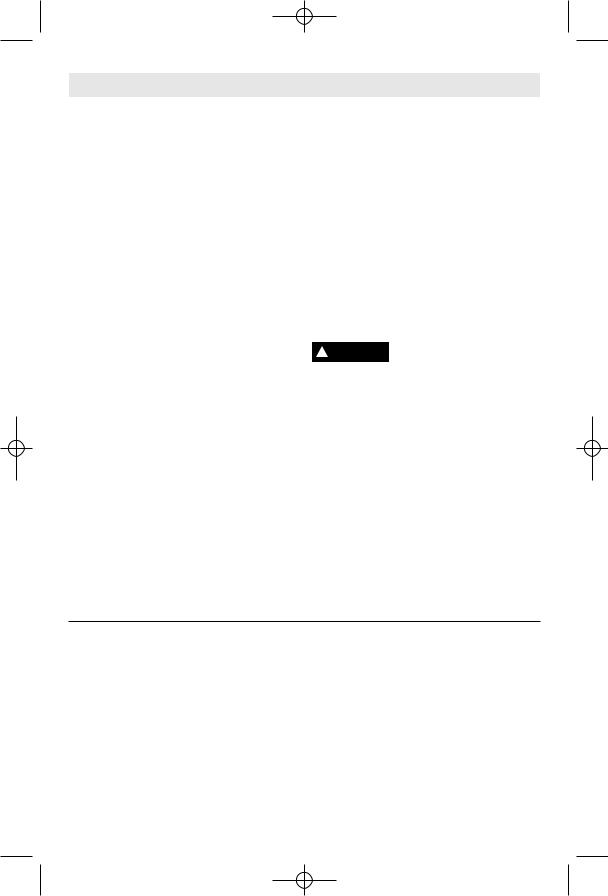
2610003213 08-08 CRS180 8/21/08 8:39 AM Page 4
Safety Rules for Cordless Reciprocating Saws
Hold power tools by insulated gripping surfaces when performing an operation where the cutting tool may contact hidden wiring. Contact with a "live" wire will make exposed metal parts of the tool "live" and shock the operator.
Use clamps or other practical way to secure and support the workpiece to a stable platform. Holding the work by hand or against your body is unstable and may lead to loss of control.
Do not drill, fasten or break into existing walls or other blind areas where electrical wiring may exist. If this situation is unavoidable, disconnect all fuses or circuit breakers feeding this worksite.
Keep hands away from cutting area. Do not reach under the material being cut.
The proximity of the blade to your hand is hidden from your sight.
Keep hands from between the gear housing and saw blade clamp (plunger).
The reciprocating blade clamp (blade plunger) can pinch your fingers.
Do not use dull or damaged blades. Bent blades can break easily or cause kickback.
Before starting to cut, turn tool "ON" and allow the blade to come to full speed. Tool can chatter or vibrate if blade speed is too slow at beginning of cut and possibly kickback.
Always wear safety goggles or eye protection when using this tool. Use a dust mask or respirator for applications, which generate dust.
Secure material before cutting. Never hold it in your hand or across legs. Small
or thin material may flex or vibrate with the blade, causing loss of control.
Make certain all adjusting screws (knobs) and the blade clamp are tight before making a cut. Loose adjusting screws and clamps can cause the tool or blade to slip and loss of control may result.
When removing the blade from the tool avoid contact with skin and use proper protective gloves when grasping the blade or accessory. Accessories may be hot after prolonged use.
When using the saw hook always be aware that the the blade is exposed.
Always hang the tool in an area where yourself and bystandards can not accidently make contact with the blade.
! Some dust created by WARNING power sanding, sawing,
grinding, drilling, and other construction activities contains chemicals known to cause cancer, birth defects or other reproductive harm. Some examples of these chemicals are:
•Lead from lead-based paints,
•Crystalline silica from bricks and cement and other masonry products, and
•Arsenic and chromium from chemicallytreated lumber.
Your risk from these exposures varies, depending on how often you do this type of work. To reduce your exposure to these chemicals: work in a well ventilated area, and work with approved safety equipment, such as those dust masks that are specially designed to filter out microscopic particles.
Battery/Charger
Before using battery charger, read all instructions and cautionary markings on
(1) battery charger, (2) battery pack, and (3) product using battery.
Use only the charger which accompanied your product or direct replacement as listed in the catalog or this manual. Do not substitute any other charger. Use only Bosch approved chargers with your product. See Functional Description and Specifications.
Do not disassemble charger or operate the charger if it has received a sharp blow, been dropped or otherwise damaged in any way. Replace damaged cord or plugs immediately. Incorrect reassembly or damage may result in electric shock or fire.
Do not recharge battery in damp or wet environment. Do not expose charger to rain or snow. If battery case is cracked or otherwise damaged, do not insert into charger. Battery short or fire may result.
-4-
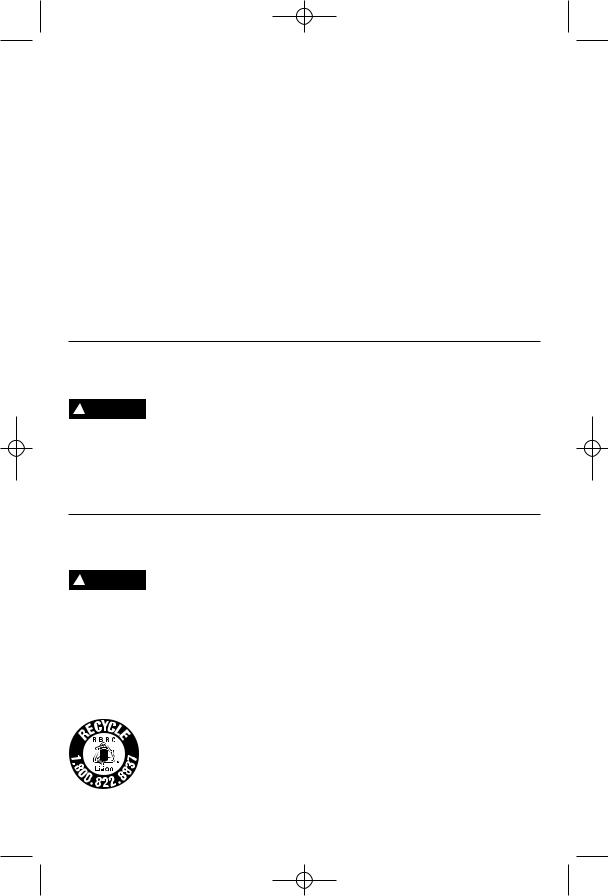
2610003213 08-08 CRS180 8/21/08 8:39 AM Page 5
Charge only Bosch approved rechargeable batteries. See Functional Description and Specifications. Other types of batteries may burst causing personal injury and damage.
Charge battery pack in temperatures above +32 degrees F (0 degrees C) and below +113 degrees F (45 degrees C). Store tool and battery pack in locations where temperatures will not exceed 120 degrees F (49 degrees C). This is important to prevent serious damage to the battery cells.
Battery leakage may occur under extreme usage or temperature conditions. Avoid contact with skin and eyes. The battery liquid is caustic and could cause chemical burns to tissues. If liquid comes in contact with skin, wash quickly with soap and water. If the
liquid contacts your eyes, flush them with water for a minimum of 10 minutes and seek medical attention.
Place charger on flat non-flammable surfaces and away from flammable materials when re-charging battery pack.
The charger and battery pack heat during charging. Carpeting and other heat insulating surfaces block proper air circulation which may cause overheating of the charger and battery pack. If smoke or melting of the case are observed unplug the charger immediately and do not use the battery pack or charger.
Use of an attachment not recommended or sold by Bosch may result in a risk of fire, electric shock or injury to persons.
Battery Care
! WARNING When batteries are not in tool or charger, keep them
away from metal objects. For example, to protect terminals from shorting DO NOT place batteries in a tool box or pocket with
nails, screws, keys, etc. Fire or injury may result.
DO NOT PUT BATTERIES INTO FIRE OR EXPOSE TO HIGH HEAT. They may explode.
Battery Disposal
! WARNING |
Do not attempt to disas- |
semble the battery or |
remove any component projecting from the battery terminals. Fire or injury may result. Prior to disposal, protect exposed terminals with heavy insulating tape to prevent shorting.
LITHIUM-ION BATTERIES
If equipped with a lithium-ion battery, the battery must be collected, recycled or disposed of in an environmentally sound manner.
“The EPA certified RBRC Battery Recycling Seal on the lithium-ion (Li-ion) battery indicates Robert Bosch Tool Corporation is voluntarily participating in an industry
program to collect and recycle these batteries at the end of their useful life, when taken out of service in the United States or Canada. The RBRC program provides a convenient alterative to placing used Li-ion batteries into the trash or the municipal waste stream, which may be illegal in your area.
Please call 1-800-8-BATTERY for information on Li-ion battery recycling and disposal bans/restrictions in your area, or return your batteries to a Skil/Bosch/Dremel Service Center for recycling. Robert Bosch Tool Corporation’s involvement in this program is part of our commitment to preserving our environment and conserving our natural resources.”
-5-
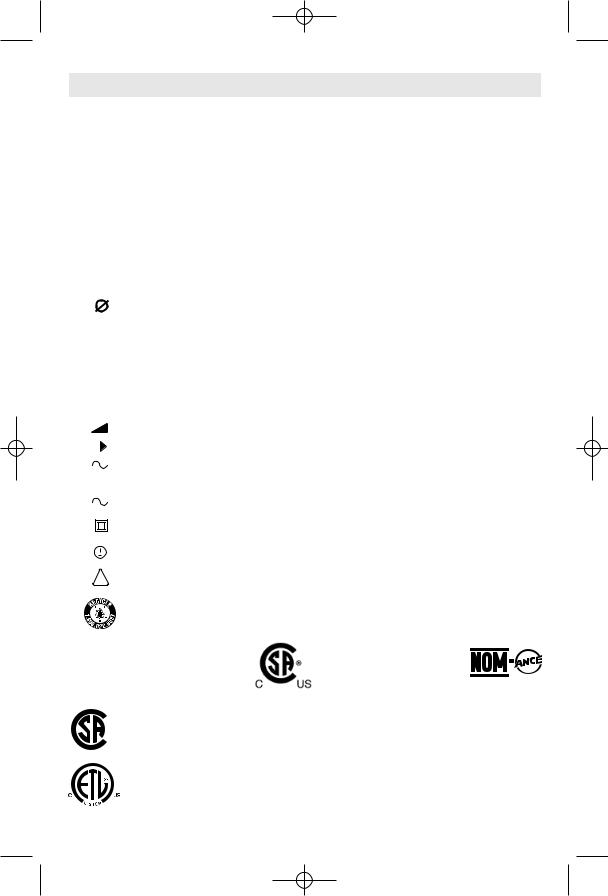
2610003213 08-08 CRS180 8/21/08 8:39 AM Page 6
Symbols
IMPORTANT: Some of the following symbols may be used on your tool. Please study them and learn their meaning. Proper interpretation of these symbols will allow you to operate the tool better and safer.
Symbol |
Name |
Designation/Explanation |
|||||||||
|
|
|
|
|
|
|
|
|
|
|
|
|
|
V |
Volts |
Voltage (potential) |
|||||||
|
|
|
|
|
|
|
|
|
|
|
|
|
|
A |
Amperes |
Current |
|||||||
|
Hz |
Hertz |
Frequency (cycles per second) |
||||||||
|
|
|
|
|
|
|
|
|
|
|
|
|
W |
Watt |
Power |
||||||||
|
|
|
|
|
|
|
|
|
|
|
|
|
kg |
Kilograms |
Weight |
||||||||
|
|
|
|
|
|
|
|
|
|
|
|
min |
Minutes |
Time |
|||||||||
|
|
|
|
|
|
|
|
|
|
|
|
|
|
|
s |
Seconds |
Time |
||||||
|
|
|
|
|
|
|
|
|
|
Diameter |
Size of drill bits, grinding wheels, etc. |
|
|
|
|
|
|
|
|
|
|
|
|
|
n0 |
No load speed |
Rotational speed, at no load |
||||||||
.../min |
Revolutions or reciprocation per minute |
Revolutions, strokes, surface speed, |
|||||||||
|
|
|
|
|
|
|
|
|
|
|
orbits etc. per minute |
0 |
|
|
|
|
Off position |
Zero speed, zero torque... |
|||||
|
|
|
|
|
|
|
|
|
|
|
|
1, 2, 3, ... |
Selector settings |
Speed, torque or position settings. |
|||||||||
I, II, III, |
|
Higher number means greater speed |
|||||||||
|
|
|
|
|
|
|
|
|
|
|
|
0 |
|
|
|
|
|
|
|
|
Infinitely variable selector with off |
Speed is increasing from 0 setting |
|
|
|
|
|
|
|
|
|
|
|
|
|
|
|
|
|
|
|
|
|
|
|
Arrow |
Action in the direction of arrow |
|
|
|
|
|
|
|
|
|
|
||
|
|
|
|
|
|
|
|
|
|
|
|
|
|
|
|
|
|
|
|
|
|
Alternating current |
Type or a characteristic of current |
|
|
|
|
|
|
|
|
|
|
|
|
|
|
|
|
|
|
|
|
|
|
Direct current |
Type or a characteristic of current |
|
|
|
|
|
|
|
|
|
|
||
|
|
|
|
|
|
|
|
|
|
||
|
|
|
|
|
|
|
|
|
|
|
|
|
|
|
|
|
|
|
|
|
|
Alternating or direct current |
Type or a characteristic of current |
|
|
|
|
|
|
|
|
|
|
||
|
|
|
|
|
|
|
|
|
|
|
|
|
|
|
|
|
|
|
|
|
|
Class II construction |
Designates Double Insulated |
|
|
|
|
|
|
|
|
|
|
||
|
|
|
|
|
|
|
|
|
|
|
Construction tools. |
|
|
|
|
|
|
|
|
|
|
|
|
|
|
|
|
|
|
|
|
|
|
|
|
|
|
|
|
|
|
|
|
|
|
Earthing terminal |
Grounding terminal |
|
|
|
|
|
|
|
|
|
|
||
|
|
|
|
|
|
|
|
|
|
Warning symbol |
Alerts user to warning messages |
|
|
|
|
|
|
|
|
|
|
|
|
|
|
|
|
|
|
|
|
|
|
Li-ion RBRC seal |
Designates Li-ion battery recycling |
|
|
|
|
|
|
|
|
|
|
|
program |
|
|
|
|
|
|
|
|
|
|
|
|
This symbol designates that this tool is listed by Underwriters Laboratories.
This symbol designates that this tool is listed by the Canadian Standards Association.
This symbol designates that this tool is listed by the Canadian Standards Association, to United States and Canadian Standards.
This symbol designates that this tool is listed by Underwriters Laboratories, to United States and Canadian Standards.
This symbol designates that this tool is listed by the Intertek Testing Services, to United States and Canadian Standards.
This symbol designates that
this tool complies to NOM Mexican Standards.
-6-
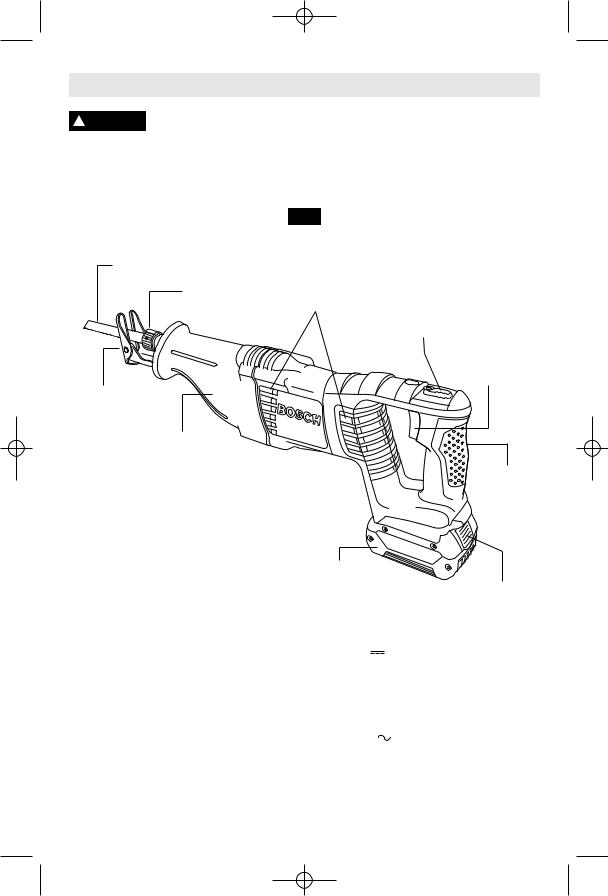
2610003213 08-08 CRS180 8/21/08 8:39 AM Page 7
Functional Description and Specifications
! WARNING Disconnect battery pack from tool before making any assembly, adjustments or changing accessories. Such preventive safety measures
reduce the risk of starting the tool accidentally.
Cordless Reciprocating Saw
FIG. 1
LockJaw™ |
VENTILATION |
|
BLADE HOLDER |
OPENINGS |
DUAL SPEED |
|
|
SELECTOR SWITCH |
|
|
& TRIGGER LOCK |
|
|
VARIABLE SPEED |
|
|
CONTROLLED |
|
|
TRIGGER |
RUBBER |
|
|
BOOT |
|
|
SAW BLADE |
|
RUBBERIZED |
|
SOFT GRIP |
|
PIVOTING |
|
|
FOOTPLATE |
|
|
|
BATTERY |
|
|
PACK |
BATTERY PACK |
|
|
|
|
|
RELEASE BUTTON |
Model Number |
CRS180 |
|
Voltage Rating |
18 V |
|
Stroke Length |
1-1/8" (28 mm) |
|
Strokes Per Minute |
n0 0-2,400/min |
|
Strokes Per Minute |
n0 0-2,700/min |
|
Battery pack |
BAT609 & BAT618 |
|
Charger |
BC630 & BC660 |
|
Voltage rating |
120 V |
60 Hz |
NOTE: For tool specifications refer to the nameplate on your tool.
-7-

2610003213 08-08 CRS180 8/21/08 8:39 AM Page 8
Assembly
Preparing the Saw
BLADE SELECTION
No one blade can be efficient on all cutting jobs. Different materials require specially designed blades. Since your reciprocating saw can cut so many materials, many types of BOSCH blades are available. Be sure to use the proper blade to insure proper cutting performance.
INSTALLING A BLADE
! WARNING Disconnect battery pack from tool before making
any assembly, adjustments or changing accessories.
1. Insert the blade into the LockJaw™ blade holder until the locking collar automatically rotates clockwise and locks the blade in place (Fig. 2). Note: if the blade will not lock automatically, rotate the locking collar counter-
FIG. 2
LOCKING
COLLAR
LockJaw™
BLADE HOLDER
BLADE
clockwise until it clicks and locks in the open position (Fig. 3).
2 Push in and pull out on the blade to be sure the pin in the clamp housing goes through the hole in the blade to hold the blade securely. The blade may be inserted with the teeth facing down or up.
3. To remove the blade, rotate the locking collar counter-clockwise and the blade will automatically eject from the LockJaw™ blade holder and lock the collar in the open position.
! WARNING |
Make sure that the front end |
of the blade extends through |
the footplate for the entire stroke length. Do not use specialty blades that are very short or those with a significant cant. Blade must not contact footplate. A blade which is too short or canted could jam inside the foot and snap.
FIG. 3
Open
Position
LOCKING COLLAR
Operating Instructions
VARIABLE SPEED CONTROLLED
TRIGGER SWITCH
Your tool is equipped with a variable speed controlled trigger switch. The tool can be turned "ON" or "OFF" by squeezing or releasing the trigger. The blade plunger stroke rate can be adjusted from the minimum to maximum nameplate stroke rate by the pressure you apply to the trigger. Apply more pressure to increase the speed and release pressure to decrease speed (Fig. 1).
! WARNING To reduce the risk of injury immediately discontinue use
of the tool if the variable speed control ceases to function. Subsequent loss of on/off control of the trigger switch is likely.
Higher speed settings are generally used for fast cutting or when softer cutting materials such as wood, composite materials, and plastics. Slower speed settings are generally used when precision is required or when cutting harder materials. Materials typically cut using slower speeds include sheet metal, conduit, and pipe.
-8-
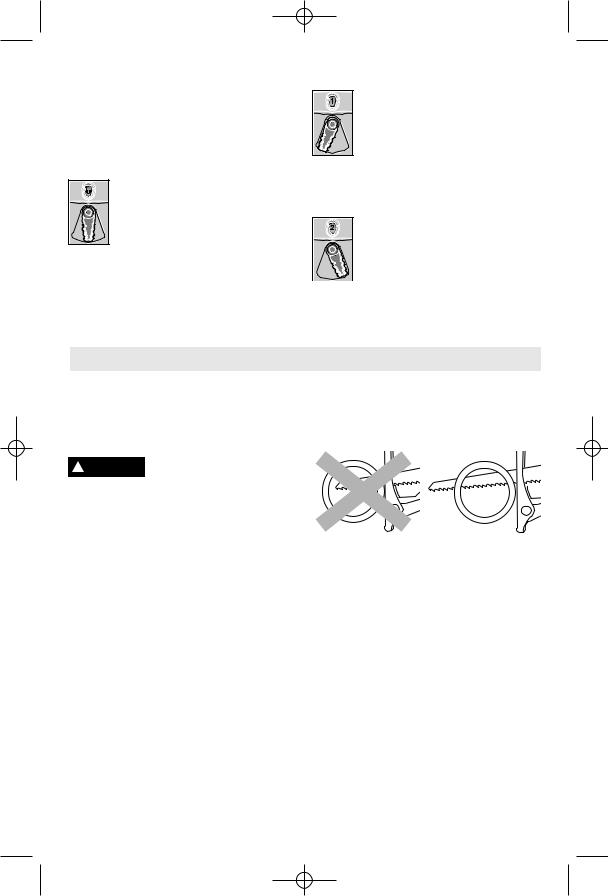
2610003213 08-08 CRS180 8/21/08 8:39 AM Page 9
DUAL SPEED SELECTOR SWITCH
& TRIGGER LOCK
The stroke speed setting of the power tool can be changed with the stroke speed selector switch. However, this is not possible when the On/Off switch is pressed.
Stroke speed selector switch – central position:
The safety lock is activated.
The On/Off switch is blocked and the machine is secured against being switched on unintentionally.
Stroke speed selector switch – left:
1. Low stroke speed.
The low stroke speed is suitable for sawing hard materials such as steel, non-ferrous metal, hard
plastics or for precision cuts in wood and plunge cutting.
The low stroke speed enables sawing with less vibrations.
Stroke speed selector switch – right:
2. High stroke speed.
The high stroke speed is suitable
for sawing soft materials.
The high stroke speed enables quicker operational progress, e. g., for coarse cuts in wood.
Using the Saw
1. Securely clamp the work.
2. Mark the line of cut and grasp the tool with one hand on the handle and the other placed on the insulated rubber boot over the front housing.
! WARNING Always operate the saw with the insulated boot on
the front housing. If you saw into a blind area where live wiring exists, you may be shocked or electrocuted.
3.Keep the saw footplate firmly against the work to minimize counter-force (jumping) and vibration.
4.Squeeze the trigger to start the tool. Let the saw reach full speed before starting the cut. Guide the saw so that the blade will move along the marked line.
SAWING TIPS
Following a few simple tips will reduce the wear on the workpiece, the tool and the operator.
1.Blades cut on the draw or back stroke. On fine work, such as paneling, fiberglass, etc., place the good side of workpiece facing down.
2.Use the correct saw blade for the material being cut and keep extra blades on hand to use when others become dull. Replace cracked or bent blades immediately.
3.Select the footplate projection settings, as well as the appropriate cutting speed.
4.To reduce the risk of injury, be sure the blade always extends beyond the footplate and work throughout the stroke. Blades may shatter if the front on the blade hits the work and/or the footplate.
WRONG |
RIGHT |
5.When cutting metal:
-Apply a lubricant for easier, smoother, faster cutting and longer blade life.
-For non-ferrous metals, aluminum, bronze or brass, use a stick wax on the blade.
-For ferrous metals, iron and steel, use machine or cutting oil along the surface to be cut.
6.When cutting thin metal, "sandwich" the material between two pieces of scrap wood. Clamp or put in a bench vise. One piece of lumber on top of the metal can be used with adequate clamping. Place your cut lines or design on the wood.
7.Don’t force the cutting. Let the saw and blade do the work.
-9-
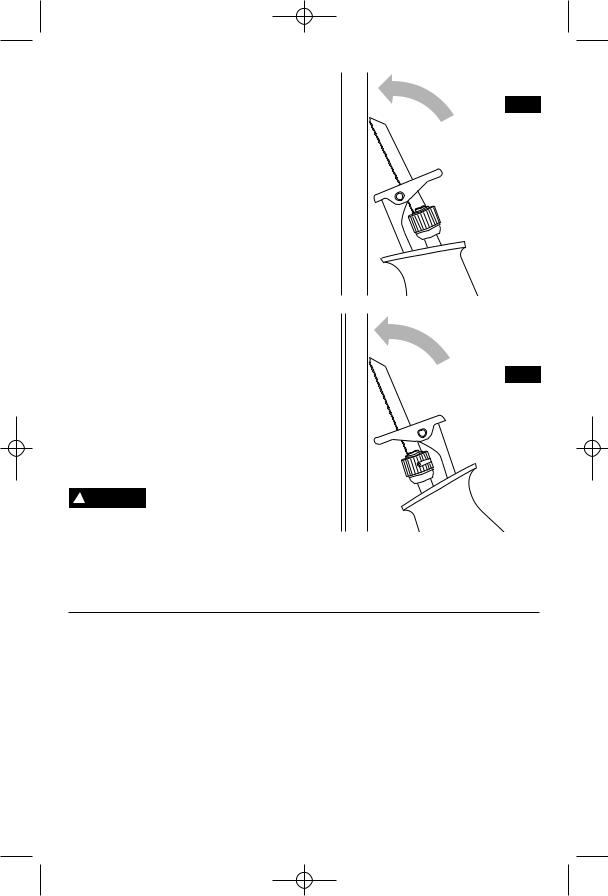
2610003213 08-08 CRS180 8/21/08 8:39 AM Page 10
POCKET CUTS
POCKET/PLUNGE CUTS
The reciprocating saw can be used to make plunge cuts into softer material, (for example, wood or light building materials for walls), without a starting hole (Fig. 6).
1.Mark the line to be cut clearly on the work.
2.Set the tool with one edge of the footplate
firmly against the material.
3. Place the tip of the blade (not running) on the line to be cut.
4. Tilt the saw so that the blade clears the work.
5. Squeeze the trigger switch and carefully engage the moving saw blade into the material.
6. After the blade penetrates through the work, continue sawing along the marked outline.
NOTES:
To make plunge cutting easier, use a heavy gauge blade, install the blade with the teeth facing upward, and hold the saw upside down as shown (Fig. 7).
Do not plunge cut in metal surfaces.
In thick materials and in harder materials, such as metal, plunge cutting should not be attempted. Such materials can be cut with the recip saw only by starting the cut from the edge of the material or from a hole drilled all the way through the material that is large enough to fit the saw blade.
! WARNING |
The use of any accessories |
not specified in this manual |
may create a hazard.
INSERTING AND RELEASING BATTERY PACK
FIG. 6
FIG. 7
Set Forward/Reversing lever to the center (off position). Slide charged battery pack into the housing until the battery pack locks into position (Fig. 1).
Your battery pack is equipped with a secondary locking latch to prevent the battery pack from completely falling out of the handle, should it become loose due to vibration.
To remove the battery pack, press the battery pack release button and slide the battery pack forward. Press the battery pack release button again and slide the battery pack completely out of tool housing.
-10-
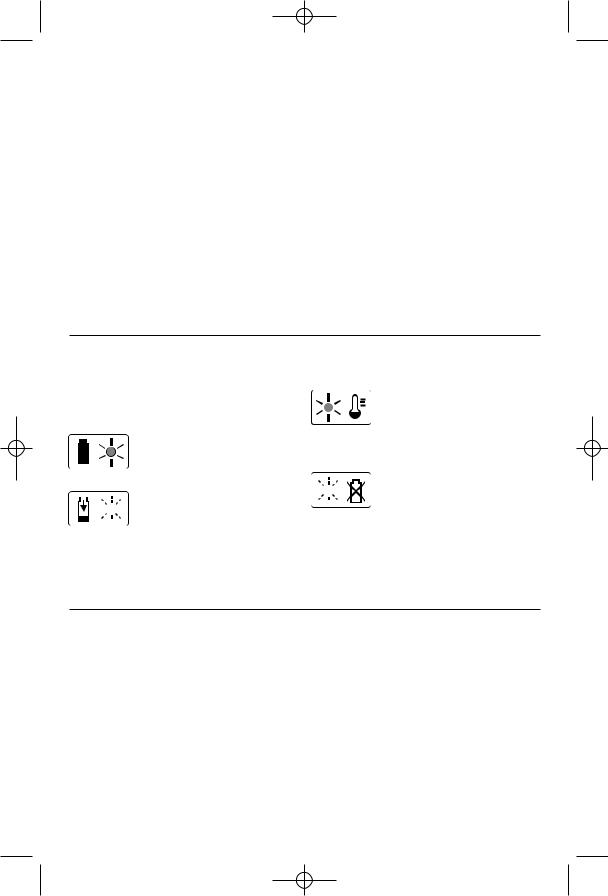
2610003213 08-08 CRS180 8/21/08 8:39 AM Page 11
IMPORTANT CHARGING NOTES
1.The charger was designed to fast charge the battery only when the battery temperature is between 32˚F (0˚C) and 113˚F (45˚C). If the battery pack is too hot or too cold, the charger will not fast charge the battery. (This may happen if the battery pack is hot from heavy use). When the battery temperature returns to between 32˚F (0˚C) and 113˚F (45˚C), the charger will automatically begin charging.
2.A substantial drop in operating time per charge may mean that the battery pack is nearing the end of its life and should be replaced.
3.Remember to unplug charger during storage period.
4.If battery does not charge properly:
a.Check for voltage at outlet by plugging in some other electrical device.
b.Check to see if outlet is connected to a light switch which turns power “off” when lights are turned off.
c.Check battery pack terminals for dirt. Clean with cotton swab and alcohol if necessary.
d.If you still do not get proper charging, take or send tool, battery pack and charger to your local Bosch Service Center. See “Tools, Electric” in the Yellow Pages for names and addresses.
Note: Use of chargers or battery packs not sold by Bosch will void the warranty.
CHARGER INDICATORS, SYMBOLS AND MEANING (Model BC630)
If the indicator lights are “OFF”, the charger is not receiving power from power supply outlet.
If the green indicator light is “ON”, the charger is plugged in but the battery pack is not
inserted, or the battery pack is fully charged.
If the green indicator light is



 “BLINKING”, the battery pack is
“BLINKING”, the battery pack is  being fast-charged. Fastcharging will automatically stop when the
being fast-charged. Fastcharging will automatically stop when the
battery pack is fully charged.
If the red indicator light is “ON”, the battery pack is too hot or cold for fast-charging. The
charger will automatically switch to fastcharging once a suitable temperature is reached.
If the red indicator light is



 “BLINKING”, the battery pack
“BLINKING”, the battery pack  cannot accept a charge or the contacts of the charger or battery pack are
cannot accept a charge or the contacts of the charger or battery pack are
contaminated. Clean the contacts of the charger or battery pack only as directed in these operating instructions or those supplied with your tool or battery pack.
CHARGING BATTERY PACK (Model BC630)
Plug charger cord into your standard power outlet.
With no battery pack inserted, the charger’s green indicator light will go ON. This indicates the charger is receiving power and the charger is ready for operation.
When you insert the battery pack into the charger. The charger’s green indicator light will begin to “BLINK”. This indicates that the battery is receiving a fast charge (Fig. 8).
When the indicator light stops “BLINKING” (and becomes a steady green light) fast charging is complete. The battery pack is fully charged and can be removed from the charger.
The battery pack may be used even though the light may still be blinking. The light may require more time to stop blinking depending on temperature.
The purpose of the green light is to indicate that the battery pack is fast-charging. It does not
-11-
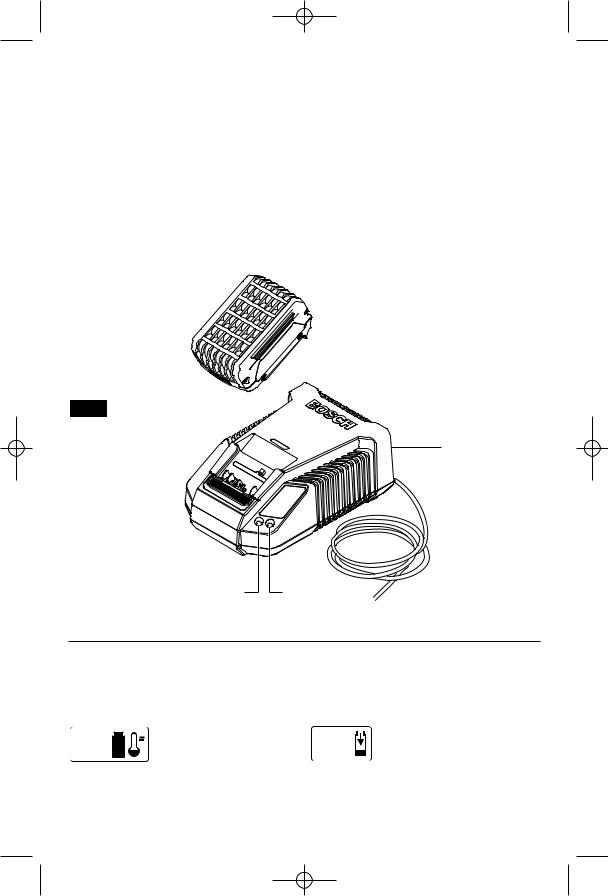
2610003213 08-08 CRS180 8/21/08 8:39 AM Page 12
indicate the exact point of full charge. The light will stop blinking in less time if the battery pack was not completely discharged.
When you begin the charging process of the battery pack, a steady red light could also mean the battery pack is too hot or too cold.
Fast charging is only possible when the temperature range of the battery pack is between 32˚F (0˚C) and 113˚F (45˚C). When needed, the internal fan of the charger will turn on to aid the charging process and speed.
As soon as the battery pack reaches the correct temperature range, the battery charger will automatically switch to fast charging.
If the red indicator light is “BLINKING”, the battery pack cannot accept a charge.
•Check to make sure the battery pack is inserted into the charger properly.
•Clean the contacts of the charger or battery pack (e. g. by inserting and removing the battery several times) or replace the battery pack, as required.
When the battery pack is fully charged, unplug the charger (unless you're charging another battery pack) and slip the battery pack back into the tool.




 BATTERY
BATTERY
PACK
FIG. 8
CHARGER
RED LIGHT |
GREEN LIGHT |
CHARGER INDICATORS, SYMBOLS AND MEANING (Model BC660)
If the indicator lights are “OFF”, the charger is not receiving power from power supply outlet.
If the green indicator light is

 “ON”, the charger is plugged in but the battery pack is not inserted, or the battery pack is fully charged, or
“ON”, the charger is plugged in but the battery pack is not inserted, or the battery pack is fully charged, or
the battery pack is too hot or cold for fastcharging. The charger will automatically switch
to fast-charging once a suitable temperature is reached.
If the green indicator light is 
 “BLINKING”, the battery pack is being fast-charged. Fastcharging will automatically stop when the
“BLINKING”, the battery pack is being fast-charged. Fastcharging will automatically stop when the
battery pack is fully charged.
-12-
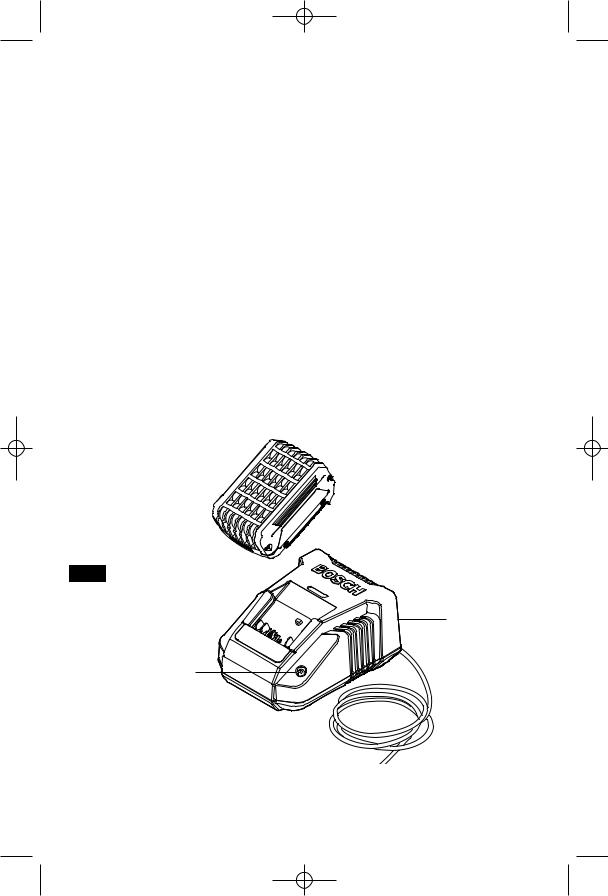
2610003213 08-08 CRS180 8/21/08 8:39 AM Page 13
CHARGING BATTERY PACK (Model BC660)
Plug charger cord into your standard power outlet.
With no battery pack inserted, the charger’s green indicator light will go ON. This indicates the charger is receiving power and the charger is ready for operation.
When you insert the battery pack into the charger, the charger’s green indicator light will begin to “BLINK”. This indicates that the battery is receiving a fast charge (Fig. 9).
When the indicator light stops “BLINKING” (and becomes a steady green light) fast charging is complete. The battery pack is fully charged and can be removed from the charger.
When you begin the charging process of the battery pack, a steady green light could also mean the battery pack is too hot or too cold.
Fast charging is only possible when the temperature range of the battery pack is between 32˚F (0˚C) and 113˚F (45˚C). When needed, the internal fan of the charger will turn on to aid the charging process and speed.
As soon as the battery pack reaches the correct temperature range, the battery charger will automatically switch to fast charging.
The battery pack may be used even though the light may still be blinking. The light may require more time to stop blinking depending on temperature.
The purpose of the green light is to indicate that the battery pack is fast-charging. It does not indicate the exact point of full charge. The light will stop blinking in less time if the battery pack was not completely discharged.
If the green indicator light is “ON”, the battery pack cannot accept a charge.
•Check to make sure the battery pack is inserted into the charger properly.
•Clean the contacts of the charger or battery pack (e. g. by inserting and removing the battery several times) or replace the battery pack, as required.
When the battery pack is fully charged, unplug the charger (unless you're charging another battery pack) and slip the battery pack back into the tool.

 BATTERY
BATTERY
PACK
FIG. 9
CHARGER
GREEN LIGHT
-13-
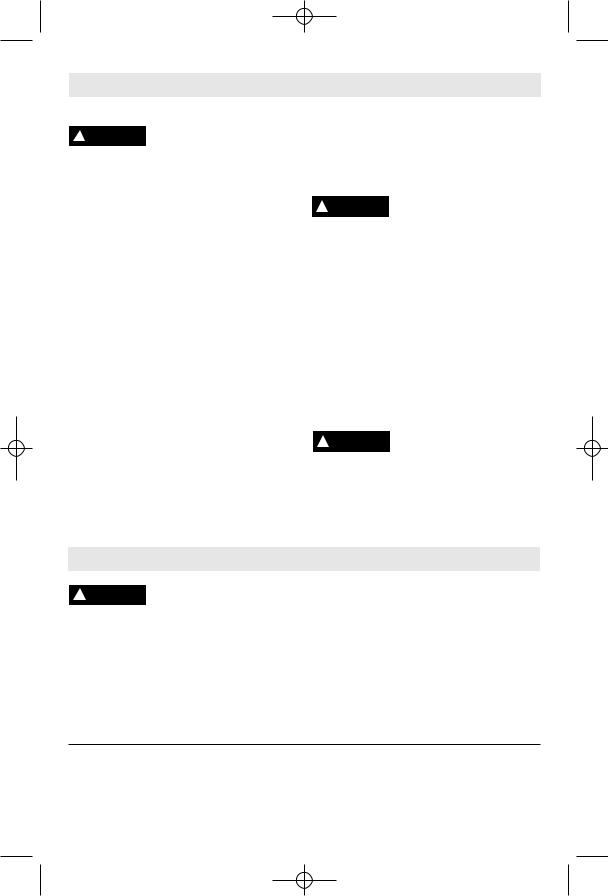
2610003213 08-08 CRS180 8/21/08 8:39 AM Page 14
Maintenance
Service
! NO USER SERVICE-ABLE WARNING PARTS INSIDE. Preventive
maintenance performed by unauthorized personnel may result in misplacing of internal wires and components which could cause serious hazard. We recommend that all tool service be performed by a Bosch Factory Service Center or Authorized Bosch Service Station. SERVICEMEN: Disconnect tool and/or charger from power source before servicing.
BATTERIES
Be alert for battery packs that are nearing their end of life. If you notice decreased tool performance or significantly shorter running time between charges then it is time to replace the battery pack. Failure to do so can cause the tool to operate improperly or damage the charger.
TOOL LUBRICATION
Your Bosch tool has been properly lubricated and is ready for use.
D.C. MOTORS
The motor in your tool has been engineered for many hours of dependable service. To maintain peak efficiency of the motor, we recommend it be examined every six months. Only a genuine Bosch replacement motor specially designed for your tool should be used.
BEARINGS
Bearings which become noisy (due to heavy load or very abrasive material cutting) should be replaced at once to avoid overheating and motor failure.
Cleaning
To avoid accidents, always ! WARNING disconnect the tool and/or
charger from the power supply before cleaning. The tool may be cleaned most effectively with compressed dry air. Always wear safety goggles when cleaning tools with compressed air.
Ventilation openings and switch levers must be kept clean and free of foreign matter. Do not attempt to clean by inserting pointed objects through opening.
LockJaw™ BLADE HOLDER MAINTENANCE
Use dry compressed air to clean dust and debris from the LockJaw™ blade holder assembly on a regular basis.
Periodically lubricate LockJaw™ blade holder with a dry lubricant such as graphite.
Certain cleaning agents ! CAUTION and solvents damage
plastic parts. Some of these are: gasoline, carbon tetrachloride, chlorinated cleaning solvents, ammonia and household detergents that contain ammonia.
Accessories
! WARNING If an extension cord is necessary, a cord with
adequate size conductors that is capable of carrying the current necessary for your tool must be used. This will prevent excessive voltage drop, loss of power or overheating. Grounded tools must use 3- wire extension cords that have 3-prong plugs and receptacles.
NOTE: The smaller the gauge number, the heavier the cord.
RECOMMENDED SIZES OF EXTENSION CORDS 120 VOLT ALTERNATING CURRENT TOOLS
Tool’s |
Cord Size in A.W.G. |
Wire Sizes in mm2 |
|||||||
Ampere |
|
|
|
|
|
|
|
|
|
Cord Length in Feet |
Cord Length in Meters |
||||||||
Rating |
|||||||||
25 |
50 |
100 |
150 |
15 |
30 |
60 |
120 |
||
|
|||||||||
3-6 |
|
|
|
|
|
|
|
|
|
18 |
16 |
16 |
14 |
0.75 |
0.75 |
1.5 |
2.5 |
||
6-8 |
18 |
16 |
14 |
12 |
0.75 |
1.0 |
2.5 |
4.0 |
|
8-10 |
18 |
16 |
14 |
12 |
0.75 |
1.0 |
2.5 |
4.0 |
|
10-12 |
16 |
16 |
14 |
12 |
1.0 |
2.5 |
4.0 |
— |
|
12-16 |
14 |
12 |
— |
— |
— |
— |
— |
— |
|
|
|
|
|
|
|
|
|
|
|
(* = standard equipment) (** = optional accessories)
-14-
